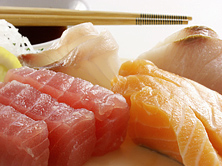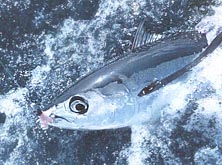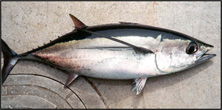Pacific Albacore Tuna (Thunnus alalunga)
- Population levels are high and overfishing is not occurring.
- Pacific albacore tuna is a highly migratory species and requires cooperative international management. The Inter-American Tropical Tuna Commission (IATTC) and the Western and Central Pacific Fisheries Commission (WCPFC) are the international management authorities.
- Albacore is very low in sodium and is a very good source of protein, vitamin A, vitamin B12, selenium, and niacin. Albacore ("white") tuna has more mercury than canned light tuna. The FDA and EPA recommend that moms, moms-to-be, and young children only eat up to 6 ounces (one average meal) of albacore tuna per week. For more on nutrition, see Nutrition Facts. (USDA)
- About one third (31%) of the albacore sold in the U.S. comes from U.S. fisheries; the rest is imported.
|
 |
 |
 |
 |
| Nutrition Facts |
| Servings 1 |
| Serving Weight
100 g |
 |
| Amount Per Serving |
 |
| Calories 108 |
 |
| Total Fat |
0.95 g |
 |
| Total Saturated Fatty Acids |
0.235 g |
 |
| Carbohydrate |
0 g |
| Sugars |
0 g |
| Total Dietary
Fiber |
0 g |
 |
| Cholesterol |
45 mg |
 |
| Selenium |
36.5 mcg |
 |
| Sodium |
37 mg |
 |
| Protein |
23.38 g |
 |
|
 |
 Since the 1970s, NOAA Southwest Fisheries Science Center has collaborated with the American Fishermen's Research Foundation in tagging studies of albacore. Through the studies, researchers have learned about the migration patterns of juvenile albacore.
Since the 1970s, NOAA Southwest Fisheries Science Center has collaborated with the American Fishermen's Research Foundation in tagging studies of albacore. Through the studies, researchers have learned about the migration patterns of juvenile albacore.
|
 |
Did you know?
Similarly sized albacore travel together in schools that can be up to 19 miles wide.
Tuna can swim continuously at speeds up to 50 mph over large areas.
Albacore lack a swim bladder and other structures needed to pump oxygen-rich water over their gills; so, in order to breathe, they must constantly swim with their mouth open.
|
|
| |
 |
|
Albacore on the line. Pacific Albacore tuna are caught commercially by troll and hook-and-line gear.
|
 |
|
The bulk of U.S. catch is canned as "white meat tuna" in American Samoa, California, and Puerto Rico, although an increasing amount of albacore is being sold as frozen loins or steaks.
|
|
Sustainability Status
Biomass: North Pacific biomass is 7% above the long-term average biomass for the exploitable stocks. South Pacific biomass is 33% above the biomass needed to support maximum sustainable yield (BMSY).
Overfishing: No
Overfished: No
Fishing and habitat: Pacific albacore tuna are caught commercially by troll, hook-and-line, and bait boat (lift-pole) gear, all of which are deployed in open waters and do not come in contact with the seafloor.
Bycatch: Troll gear is mainly used in the U.S. North Pacific fishery, and bycatch is not a significant issue. Bait boat gear is also used and has virtually no bycatch. Longline gear is the major source of U.S. albacore catch in the South Pacific. Sea turtles may be a bycatch concern, but extent of this is not known and is currently being researched. The most common bycatch mitigation measure for sea turtles is the use of circle hooks, which are the hook of choice in the U.S. South Pacific longline fishery.
Aquaculture: There is currently no commercial aquaculture of albacore tuna in the U.S.
|
Science and Management
Pacific albacore is a highly migratory species (HMS); it moves throughout large areas of the Pacific Ocean and is fished by many nations and gear types. The main albacore fisheries in the Pacific are roughly divided at the equator into North and South Pacific stocks. The North Pacific stock is managed under both the Pacific Fishery Management Council's (PFMC) HMS Fishery Management Plan (FMP), partially approved in February 2004, and the Western Pacific Fishery Management Council's (WPFMC) Pelagic Fisheries of the Western Pacific Region FMP, implemented in March 1987. The South Pacific stock is solely managed through WPFMC's Pelagics FMP.
As of April, 2005, the HMS FMP required commercial fishermen to obtain a permit from NOAA Fisheries Service and maintain logbooks documenting their catch. Recreational charter vessels are also required to keep logbooks. There are no quotas, time/area closures, gear restrictions or limitations on participation in this fishery. Status of the North Pacific stock is reviewed at 1- to 2-year intervals. Landings are primarily monitored through the processing facilities (canneries). The U.S.-based albacore fisheries primarily target the North Pacific population, and there is also an important recreational fishery for North Pacific albacore, capturing up to 1,500 metric tons (3.3 million pounds) in some years.
In addition, because albacore is highly migratory, management by the U.S. alone is not enough to ensure that harvests are sustainable in the long term. The U.S. is a party to both the Inter-American Tropical Tuna Commission (IATTC) and the Western and Central Pacific Fisheries Commission (WCPFC). These commissions are responsible for the international conservation and management of tuna and tuna-like species in the Pacific Ocean. The Northern Pacific stock of albacore tuna is managed cooperatively by the IATTC and WCPFC. In 2005, both organizations adopted conservation and management measures limiting future catches of Northern Pacific albacore tuna to 2005 levels. The Southern Pacific stock of albacore tuna is managed internationally by the WCPFC. In 2005, the WCPFC adopted a conservation and management measure for Southern Pacific albacore, capping the number of fishing vessels per participating and cooperating party at 2005 levels or recent historical levels (2000-2004).
The U.S./Canadian Albacore Treaty allows for an agreed number of both nations' vessels to fish for the North Pacific stock of albacore in the others EEZ, as well as access to each others ports for landing catches. The Food and Agriculture Organization of the United Nations (FAO) is also involved in HMS management.
|
Life History and Habitat
Life history, including information on the habitat, growth, feeding, and reproduction of a species, is important because it affects how a fishery is managed.
- Geographic range: In tropical, subtropical, and temperate zones of the Pacific, Atlantic, and Indian Oceans.
- Habitat: Temperature is a major determining factor in Pacific albacore habitat. Juveniles are often found near oceanic fronts or temperate discontinuities; adults occur to at least 1,250 feet deep. They will also explore deeper waters in search of prey.
- Life span: Maximum of 11-12 years
- Food: Pacific albacore are top carnivores. They opportunistically prey on schooling stocks, such as sardine, anchovy, and squid. They eat an enormous amount of food to fuel their high metabolism, sometimes consuming as much as 25% of their own weight every day.
- Growth rate: Eggs develop rapidly, hatching within 24 to 48 hours. Juveniles grow at an estimated 1.23 inches per month. Growth progresses more slowly with age.
- Maximum size: Grow up to 79 pounds in weight and about 47 inches in length
- Reaches reproductive maturity: At roughly 5 to 6 years old and 33.5 inches in length
- Reproduction: Females have 0.8 to 2.6 million eggs per spawning (100,000 eggs per 2.2 pounds of body weight). They broadcast the eggs in water near the surface, where they are externally fertilized.
- Spawning season: From March to July; there is some evidence that albacore spawn multiple times a year.
- Spawning grounds: In subtropical waters in the Pacific centered around 20 degrees North to 20 degrees South latitude
- Migrations: Pacific albacore, particularly juveniles (2-5 years old), typically begin an expansive migration in the spring and early summer in waters off Japan that continues through the late summer into inshore waters off the U.S. Pacific coast, and ends in late fall and winter in the western Pacific Ocean. The timing and geographic extent of the albacore's migration in a given year is strongly influenced by oceanic conditions.
- Predators: Predators of albacore include larger species of billfish, tuna, and sharks.
- Commercial or recreational interest: Both
- Distinguishing characteristics: Pacific albacore are metallic, dark blue on the back with dusky to silvery white coloration along the sides of the belly. They have exceptionally long pectoral fins, which are nearly half the length of their body.
|
Role in the Ecosystem
Pacific albacore are top carnivores, preying on schooling stocks such as sardine, anchovy, and squid. Pacific albacore are eaten by larger species of billfish, tuna, and sharks.
|
Additional Information
Albacore, like other species of tuna, have unique biological characteristics that enable them to swim at speeds over 50 miles per hour and cover vast areas during annual migrations. They have torpedo-shaped bodies, smooth skin, and streamlined fins. They also have a highly evolved circulatory system which regulates their body temperature and increases muscle efficiency; a high metabolism; and higher blood pressure, volume, and hemoglobin, all which increase oxygen absorption.
Market name: Tuna
Vernacular names: Germon, Longfinned tuna, Albecor, T. Gero
Several other species are also marketed as Tuna.
|
Biomass
 Biomass refers to the amount of Pacific albacore in the ocean. Scientists cannot collect and weigh every single fish to determine biomass, so they use models to estimate it instead. These biomass estimates can help determine if a stock is being fished too heavily or if it may be able to tolerate more fishing pressure. Managers can then make appropriate changes in the regulations of the fishery. Biomass refers to the amount of Pacific albacore in the ocean. Scientists cannot collect and weigh every single fish to determine biomass, so they use models to estimate it instead. These biomass estimates can help determine if a stock is being fished too heavily or if it may be able to tolerate more fishing pressure. Managers can then make appropriate changes in the regulations of the fishery.
Landings
 Landings refer to the amount of catch that is brought to land. Landings refer to the amount of catch that is brought to land.
Note: U.S. commercial landings are presented in the graph.
Biomass and Landings
 Are landings and biomass related? Landings are dependent on biomass, management measures in the fishery, and fishing effort. Are landings and biomass related? Landings are dependent on biomass, management measures in the fishery, and fishing effort.
Note: Biomass and landings are presented on different scales in the graph.
Data sources:
South Pacific biomass from Langley, A. and J. Hampton. 2006. An update of the stock assessment for South Pacific albacore tuna, including an investigation of the sensitivity to key biological parameters included in the model. WP SA-4, WCPFC-SC2, Manila, Philippines, 7-18 August 2006.
North Pacific biomass from Stocker, M. (Ed.) 2005. Report of the nineteenth north Pacific albacore workshop. Nineteenth North Pacific Albacore Workshop, Nanaimo, B.C., Canada, Nov 25-Dec 2, 2004. Fisheries and Oceans Canada, Pacific Biological Station, Nanaimo, B.C. 127 pp.
Landings from NOAA's National Marine Fisheries Service (NMFS) Annual Commercial Landing Statistics Website using "TUNA, ALBACORE" as species and "PACIFIC"
|
Important Dates
1950 – IATTC established by international convention
1972 – Albacore fishery in Washington flourishes
1981 – U.S. and Canada Treaty on Pacific Coast Albacore Tuna Vessels and Port Privileges; permits fishing vessels of each nation to fish for albacore in waters of the other nation beyond 12 miles
1986 – U.S. fishery expands to South Pacific on a limited basis; only accounts for about 2% annually of S. Pacific albacore catch
1991 – Pelagics FMP implemented along with Amendment 1, which defines recruitment overfishing and optimum yield, and Amendment 2, which implements permitting and logbook requirements for domestic pelagic longline fishing and transshipment vessel operators
1991 – Amendment 3 to Pelagics FMP creates a longline exclusion zone around the Northwestern Hawaiian Islands to protect endangered Hawaiian monk seals; also implements a framework for establishing an observer program for interactions between longline fishing and sea turtles
1994 – Amendment 7 to Pelagics FMP institutes a limited entry program for the Hawaii-based domestic longline fishery
1999 – Amendment 8 to Pelagics FMP designates essential fish habitat, describes fishing communities, and defines overfishing and bycatch
2004 – Combined EIS and FMP for HMS developed by the Pacific Fishery Management Council and partially approved by NOAA Fisheries Service
2004 – Western and Central Pacific Fisheries Commission (WCPFC) established
2005 – Permitting and logbook requirements implemented through HMS FMP
2005 – Amendment 11 to Pelagics FMP establishes a limited access system for pelagic Longlining in EEZ waters around American Samoa
2007 – U.S. becomes a member of the WCPFC
2007 – Final rule implements daily bag limits for sport-caught Pacific albacore off the EEZ of California; bag limits are 10 albacore south of Point Conception to the U.S.-Mexico border and 25 albacore north of Point Conception to the California-Oregon border
|
Notes and Links
General Information:
NOAA Southwest Fisheries Science Center Albacore Research
Pacific Fishery Management Council Background on Highly Migratory Species
Pacific Fishery Management Council Highly Migratory Species Fact Sheet
Western Pacific Fishery Management Council Reports: Important Pelagic Fishes of the Pacific
Inter-American Tropical Tuna Commission
Western and Central Pacific Fisheries Commission
Fishery Management:
Pacific Fishery Management Council Highly Migratory Species Fishery Management Plan
Western Pacific Fishery Management Council Fishery Management Plan for Pelagic Fisheries of the Western Pacific Region
Stock Assessments:
Western Pacific Fishery Management Council Pelagic Fisheries of the Western Pacific Region 2005 Annual Report
Pacific Fishery Management Council Stock Assessment and Fishery Evaluation Document (SAFE) Status of the U.S. West Coast Fisheries for HMS through 2005 (2006)
Western and Central Pacific Fisheries Commission Report of the 19th North Pacific Albacore Workshop (2005)
|
| |
|



